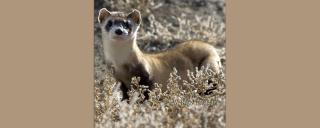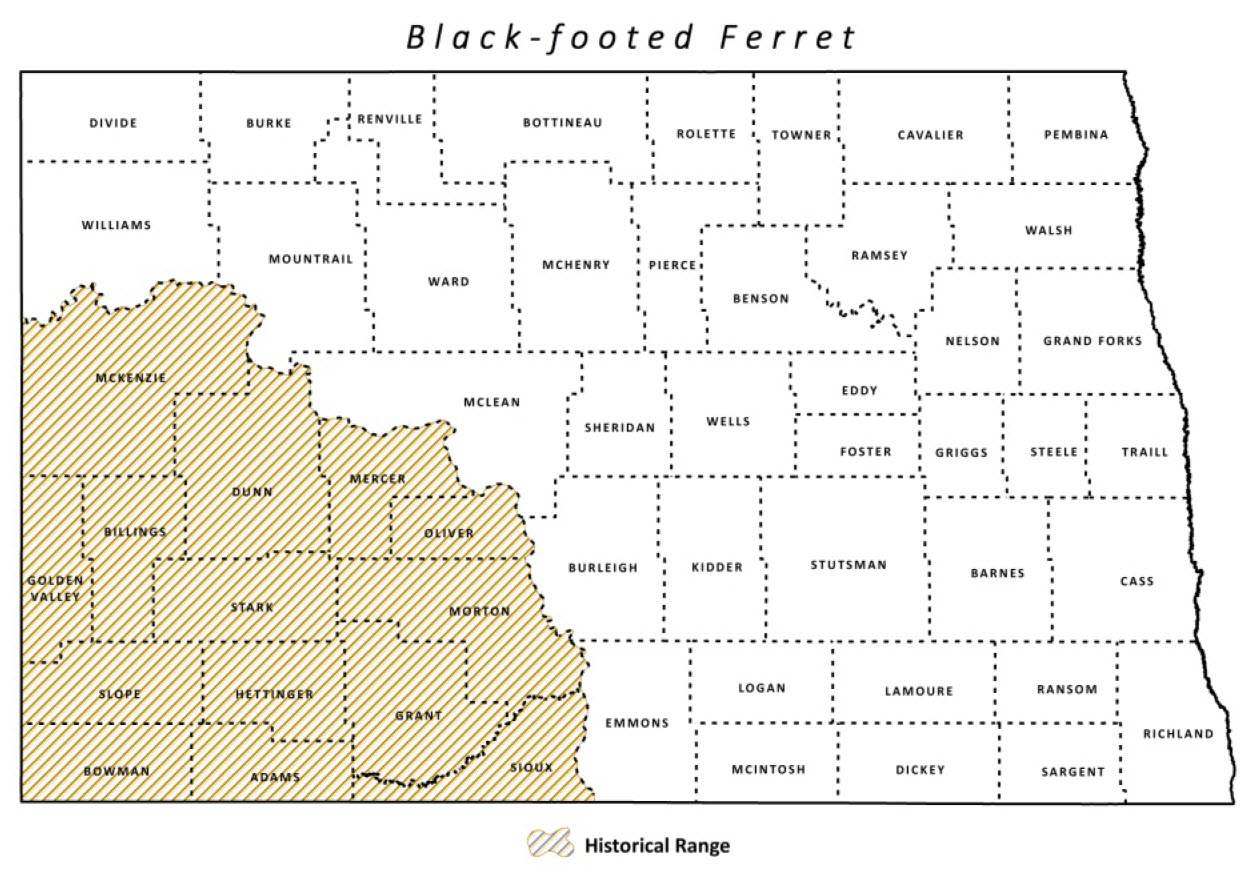
Black-footed Ferret
| Scientific Name | Mustela nigripes |
|---|---|
| General Description | A mink-sized member of the weasel family, up to 26 in. in length. Pelage is buff with the throat and belly generally whiter. The feet are black, as is the tip of the tail. A black band covers the eyes, and is more prominent in younger individuals. |
| Status | Believed Extirpated. |
| Abundance | Rare. |
| Primary Habitat | Associated exclusively with prairie dog towns. Use burrows for shelter and feeds on prairie dogs and other species that live within the town. |
| Federal Status | Endangered. |
| Reason for Designation | Extirpated from North Dakota in the early 1950s. Records of sightings continued until the 1970s. Poisoning efforts directed toward the Black-tailed Prairie Dog in the early part of the century caused the decline and eventual loss of North Dakota’s ferret population. |
Locations and Conditions of Key Habitat
Preferred Habitat
Black-footed Ferrets require large complexes of prairie dog colonies, 10,000 acres or more with towns no farther than three miles apart to sustain a viable population of 120 ferrets.
Key Areas and Conditions for Black Footed Ferret in North Dakota
The Little Missouri National Grasslands and the Standing Rock reservation may be suitable areas if Black-tailed Prairie Dog populations were to expand.
Problems Which May Affect this Species
Habitat
Large prairie dog complexes needed to support a Black-footed Ferret population do not currently exist in North Dakota. With widespread negative sentiment toward prairie dogs within the state it is uncertain whether prairie dog complexes would be allowed to expand sufficiently to support ferret reintroduction.
Other Natural or Manmade Factors
Poisoning of Black-tailed Prairie Dog colonies has resulted in loss of population. Poisoning is legal on private land in North Dakota. Many types of poisons are used, but zinc phosphide and Rosal are the most common. Conversion of rangeland for agricultural uses is decreasing Black-tailed Prairie Dog acres within the state, which in turn reduces potential Black-footed Ferret habitat.
Research and Survey Efforts
Current Research or Surveys
- A fringe mammal study is being conducted by Northeastern State University. Black-footed Ferret is included in this study.
Previous Research or Surveys
- Black-tailed Prairie Dog colonies are surveyed every six years by the North Dakota Game and Fish Department to estimated population status.
- The U. S. Forest Service Dakota Prairie Grasslands office conducts surveys every three years on Forest Service land in its region.
- Theodore Roosevelt National Park surveys towns within their lands yearly.
Additional Research or Surveys Needed
Potential sites for Black-tailed Prairie Dog expansion need to be identified before ferret reintroduction can be considered.
Management Recommendations
- Management recommendations for the recovery of the Blackfooted Ferret are outlined in the Black-footed Ferret Recovery Plan. http://www.fws.gov/mountainprairie/mammals/blackfooted ferret/2013DraftRevisedRecoverPlan.pdf (pdf)
Monitoring Plans
Prairie dog towns will be monitored for Black-footed Ferrets during Black-tailed Prairie Dog survey efforts.
2005-2015 Progress
The Black-footed Ferret continues to be a Level I Species of Conservation Priority. It is still considered extirpated from the state. Reintroductions in neighboring states may provide a conduit for re-colonization outside of reintroduction.

Note: A listing of works consulted when compiling the information on this page may be found in the 2015 State Wildlife Action Plan.
